Huawei MateBook X Pro (2021) Review: A Sleek and Vibrant Notebook
by Dr. Ian Cutress on September 28, 2021 9:00 AM EST- Posted in
- Notebooks
- Intel
- Huawei
- Laptops
- Matebook X Pro
- Tiger Lake
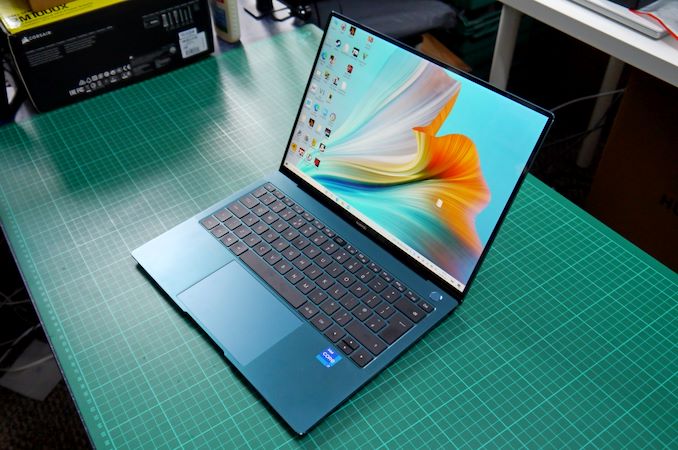
As a laptop vendor, Huawei is entering its fourth year. Relying on x86 silicon and a GPU here and there, one thing Huawei does well is the quality of the design. The company has transferred the knowhow developed over a decade of smartphones into something bigger, with a keyboard, running Windows. The latest MateBook X Pro 2021 edition we’re testing today equips an Intel 11th Gen Core i7 with one of the physically largest displays you can fit into a 14-inch device, and a brushed aluminium chassis that’s very smooth to the touch and an Emerald Green finish that really stands out.
Huawei Makes Laptops? Really?
Over the years that we have covered Huawei products, through the good and the bad, through the first attempts and halo devices, a main feature that’s hard to ignore is the design. After a decade of Huawei smartphones, we were introduced to the first 2-in-1 laptop products in 2017, and although well designed and comforting to handle, the user experience needed some work. But it wasn’t long before we got a Windows device that looked great with an experience to rival market veterans.
Enter the first generation MateBook 13, and it is easily one of the best laptops I’ve used as a 6-month travel work machine to date. Unfortunately due to some improvements Huawei wanted to introduce (like the recessed webcam, more on that later), the company quickly replaced it with a less inspiring configuration that wasn’t as well received. Huawei has traditionally gone with Intel in its systems, but was one of the first to partner with AMD when the AMD Mobile Ryzen became available – we saw Ryzen versions of its education model, albeit for China only.
Huawei’s laptop ambitions right now are in three main categories
- Education with the MateBook D 14, MateBook D 15, and MateBook D 16
- Portable with the MateBook 13, MateBook 14, and MateBook 16
- Professional with the MateBook X (13-inch) and MateBook X Pro (13.9-inch).
Those last two categories being aimed squarely at the traditional MacBook markets.
Today we’re testing the Huawei MateBook X Pro 2021 model, which features an Intel 11th Generation Tiger Lake Core i7 processor and uses integrated graphics, paired with 16 GB of LPDDR4X memory and a 512 GB NVMe SSD. Normally people might associate a Pro laptop with a discrete GPU included - in the 2020 model, Huawei used a 10th Gen processor with an NVIDIA MX250 discrete GPU, but that has been dropped in favour of Intel’s integrated Xe Graphics.
Huawei MateBook X Pro 2021: Hands On
When you first take a new laptop out of the box, after picking it apart from the Styrofoam and removing the protective plastic wrapping, you touch the chassis. For most devices, this is a mundane affair, as you’re touching plastic or something equally utilitarian. Higher cost devices will have an aluminium unibody, saving weight, or if you’re going for something even lighter, an expensive lithium-magnesium alloy can be an option. However, even with a metallic unibody design, not all are equal, and it comes down to how that chassis is treated, etched or finished, and treated as part of the design. With this MateBook, it has that touch that is very smooth but if you softly move your hand over it, you get a small vibration sensation. In my mind, it’s great. I’ve asked people if they feel the same thing. They have no idea what I’m going on about.
Opening the lid, we see a chiclet-style keyboard with a massive touchpad and a separate power button in the top right corner. In its MateBook designs, Huawei integrates the same high-speed Goodix fingerprint recognition sensor into the power button as it does with its smartphones, which has grown to be one of the easiest to use in the market with a fast response and near-perfect recognition.
The fact that this power button is a separate button entirely on the keyboard should not be understated. I loathe the in-keyboard power buttons that are often to the right of the delete key, as they get pressed way too often by accident. I also loathe designs with the power button on the side, because invariably when trying to move a laptop closer to see better, that button will always get pushed. Huawei has it in the correct position here, and it also comes with a small click to know when it’s pressed. You don’t need to click it to get the fingerprint sensor to work, which is a bonus.
The large touchpad is Huawei’s latest iteration, and having had some dodgy trackpads in the past, this one works well and is easy to use with a good palm rejection and a slight click on both the left and right for the respective mouse button presses. Gestures sometimes took a couple of tries to activate, but no more so than most other premium touchpads I’ve tested. The touchpad doesn’t have the same feel as the chassis that I mention above, which is perhaps a good thing – I found it very easy to be accurate with mouse movements with the touchpad too.
They keyboard uses a slight bevel on each key to make it easier to hone in on the chiclet style, however the half-size up/down arrows aren’t always fun to play with. As with most laptops, there is a second function for the top row of F keys, and the Huawei design allows the user to operate with the Fn/Function key permanently on or off, and selecting between the two is just a simple press. On other laptops I’ve noticed that sometimes requires a BIOS option change, so the fact that this is on the keyboard helps. Every key is white backlit as well. Perhaps the oddest different to most laptops is where the camera sits.
Since 2018, Huawei has decided to remove the built-in webcam from the chassis lid. We normally find it above the display, but that either compromises the look of the display, or you end up with a really bad and tiny camera. Some vendors remove it entirely, but Huawei has relocated it to the Function key row. It sits just below the key between F6 and F7, and which you click it, it springs up from its spot and points up at you.
This fulfils the tick on the spreadsheet of having a built-in camera. However, the camera isn’t great: the quality is still a standard 720p camera that you would find in the chassis lid on other laptops, except this one points right up at your chin. And up your nose. I don’t know about you, but having to have critical meetings while looking up at someone’s nose hair isn’t the greatest experience. Usually I recommend that if you are going to have a video call with a laptop web-cam embedded in the display, then put the laptop up on some books, so at least the camera is at eye-level rather than looking up. The Huawei solution does the reverse, and makes it a poor experience for all concerned. I would suggest looking at external cameras here.
But the benefit of removing the webcam from the chassis is that Huawei has fitted one of the biggest 14-inch class displays to a 13.9-inch notebook. Huawei lists the screen-to-body ratio as 91%, and the LTPS display has a 3000x2000 resolution in a 3:2 aspect ratio, giving it 260 pixels per inch. The official specifications for the display rate it as at 450 nits brightness, with a 1500:1 contrast ratio with 100% sRGB gamut. The display also supports 10-point multi-touch – we’ll go more into verifying these claims during our display testing later in the review. But as with many devices that look great when the screen is right up against the display, it’s hard not to be astounded by how much display real estate there is here.
For connectivity, on the left the MateBook X Pro 2021 has a 3.5mm audio jack and two USB Type-C ports (support for dual 4K60 display, 50W charging, or data). On the right is a single USB 3.2 Type-A port. Inside is a Wi-Fi 6 controller with BT5.1 support, as well as a Huawei Share NFC module. Users with a Huawei smartphone that supports Huawei Share can dock it to the laptop wirelessly to share the displays with each other, use the phone as a remote control, use the laptop to take and make calls, or an easy way to share pictures and videos in either direction.
| Huawei Matebook X Pro Specifications | |||||
| AnandTech | 2018 | 2019 | 2020 | 2021 | |
| Processor | CPU | i7-8550U | i7-8565U | i7-10510U | i7-1165G7 |
| Cores | 4C + HT | 4C + HT | 4C + HT | 4C + HT | |
| TDP | 15 W | 15 W | 15 W | 15 W | |
| Base Freq | 1.8 GHz | 1.8 GHz | 1.8 GHz | 1.7 GHz | |
| Turbo Freq | 4.0 GHz | 4.6 GHz | 4.9 GHz | 4.7 GHz | |
| L3 | 8 MB | 8 MB | 8 MB | 12 MB | |
| uArch | Kaby | Whiskey | Comet | Tiger | |
| Graphics | NVIDIA MX150 2GB GDDR5 |
NVIDIA MX250 2 GB GDDR5 |
Xe-LP 96 EUs |
||
| Display | 13.9-inch, 3000x2000 100% sRGB, LTPS Panel 450 nits. 1500:1 contrast 10-point touch |
||||
| DRAM | 16GB LPDDR3 |
16GB LPDDR3 |
16GB LPDDR3 | 16GB LPDDR4X | |
| Storage | 512 GB NVMe PCIe 3.0 x4 |
512 GB NVMe PCIe 3.0 x4 |
512 GB NVMe PCIe 3.0 x4 |
1 TB NVMe PCIe 3.0 x4 |
|
| Wireless | Wi-Fi 5 | Wi-Fi 5 | Wi-Fi 5 | Wi-Fi 6 | |
| Camera | Spring Latch, 1MP | ||||
| Battery | 57.4 Wh | 57.4 Wh | 56 Wh | 56 Wh | |
| Weight | 1.33 kg | 1.33 kg | 1.33 kg | 1.33 kg | |
| Price | ¬$1800 | ~$1810 | ~$1900 | ~$1500 | |
Inside our model is the Intel Core i7-1165G7, the entry level Core i7 but with the biggest Xe graphics option, which is paired with 16 GB of LPDDR4X-4266 and a 1 TB Samsung PM981a NVMe SSD. The 56 Wh battery is rated for 10 hours of local video playback, which we’ve tested later in the review. At 1.33 kg (2.9 lbs), the metal unibody design does make it light for its 13.9-inch laptop size. Alongside the Emerald Green color of our unit, Huawei also offers a Space Grey. Our device shipped with Windows 10 Home, however a free upgrade to Windows 11 will be rolled out in due course.
Other features of the notebook include a dual Shark Fin fan design inside the chassis, so even without a discrete GPU, the cooling is sufficient and designed to be quiet. There is also a quad-speaker design, as well as two front facing microphones.
Over the next few pages, we’ll cover the performance, display, battery life, charging, and other aspects of the system.


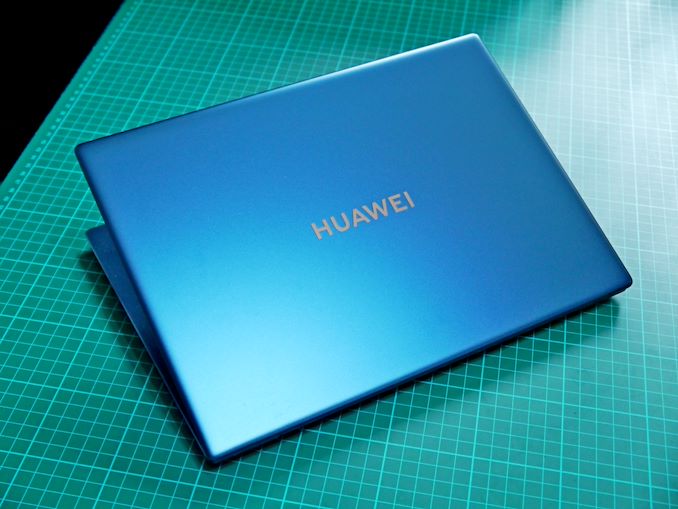

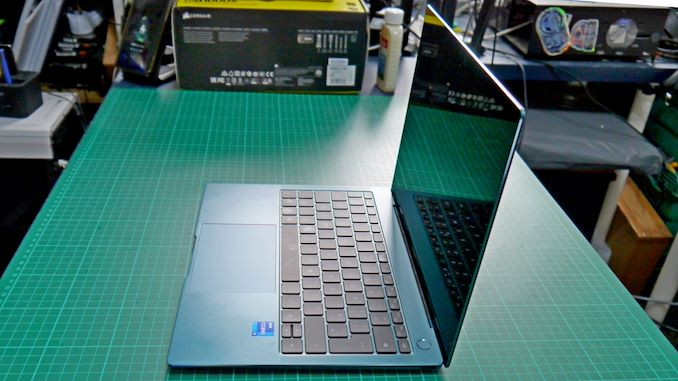
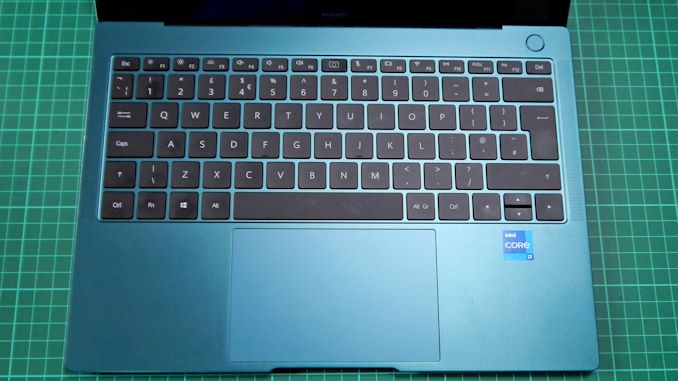
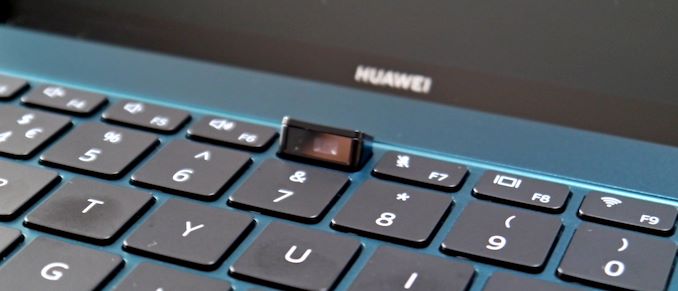
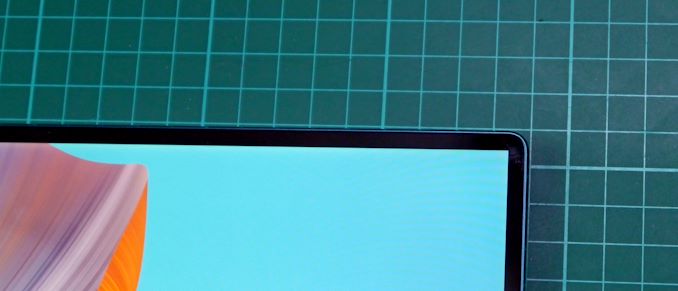


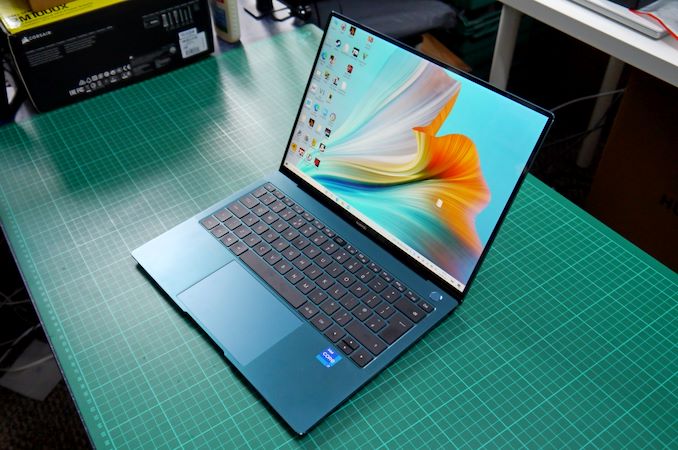








84 Comments
View All Comments
Oliveira_Salazar - Tuesday, September 28, 2021 - link
Very poor review.No direct comparisons with the latest MacBook Air. No M1 mention at all.
It would be extremely easy to include the MacBook Air and/or Pro in a lot if not most of these benchmarks/comparisons. Even the Intel version.
The MBA is the default laptop of this category and everything should be considered against it. Let's not even mention how inspired Huawei is by MBP's designs. You mention that they are trying to place this in a segment where the Macs are their main competition, but don't feature them in any testing at all?
It's pathetic.
This machine is absolutely obliterated performance wise in all metrics. Specially while on battery.
You only make a poor argument that "an equivalent specced Mac is +800$", but "wins on battery life and performance". Is that fair? Is that the whole relevant story? Wouldn't a competent review also include something like "a 500$ to sometimes 600$ cheaper, completely silent MacBook Air beats this in almost all performance metrics and usage scenarios, sometimes by a lot, and wins heavily in battery life too, but only has 8GB of RAM and 256GB of storage, while a version with the same RAM and Storage costs only 100 to 200$ more"
Why isn't there detailed performance testing while on battery power? These are thin and light machines for a reason. It's incredibly low effort to default to a pathetic "browsing test" and "200 nit video playback" to measure battery life.
People use these devices on the road. The default state of all laptops is unplugged. All performance testing should be done by default while on battery, and a separate one while plugged in, all conditions the same, and conclusions should be made.
Unless someone really really needs windows, these laptops should never be recommended at this point. They have are horrific value compared to what an Air offers while on battery.
But people that only read this review wouldn't know.
dontlistentome - Tuesday, September 28, 2021 - link
I'll bite.The MBA is the default laptop of this category - no, it really isn't. If you need to fit into a Windows infrastructure, the default will likely have a HP, Dell or Thinkpad logo on it. Macs are *horrible* to use in a corporate environment. Given their input into the protocol the Thunderbolt implementation is borked (mostly round MST tagging for multiple displays). But then again the MBA can only drive one external panel.
Your price comparisons are **way** out. A Macbook with 16gb/512GB is not $200 more, it is $400 more minimum - the closest comparitor to this is $1450 - $50 less and that's before discounts which don't exist on Apple.
My team has 50+ laptops - mostly Thinkpad X1 Carbon of various gens, some Macs for the off balls. They are used 95% at a desk with power. That's the PCs and Macs (including the M1 Macbooks).
Go off and have a cuddle with your Macbook and feel great about what a genius you are. Meanwhile the rest of the world is still Windows.
lemurbutton - Tuesday, September 28, 2021 - link
I'll bite.The Macbook Air M1 is significantly better than this laptop, and any Windows laptop in its class. Windows itself is less advanced than MacOS. The only thing Windows has that the Mac doesn't is AAA games. That's it. The Mac does everything else better.
Your Thinkpad X1 Carbon sucks compared to M1 Macs.
They should fire you for not buying M1 Macs.
dontlistentome - Tuesday, September 28, 2021 - link
I have both (X1 Gen 9 / MBA M1). Do you?dnanatech - Wednesday, September 29, 2021 - link
I have/had all of those (i7 X1gen6, i7 Matebook XP 2018, M1 MBA), and i7 Latitude 7390.The Mac is significantly better than all 3. X1 has unreliable fingerprint reader, a dim screen, weirdo Fn vs Cntrl key layout (i know it can be re-mapped in BIOS), overheats like a furnace, etc.
Worst of all, all the Windows machine have various battery-performance issues (sleep/hibernate drain, pickiness on chargers, low charging rate, etc), some of which is due to the common OS layer, and some of which is hardware unique to each machine.
It's not limited to these 4 device samples and generation. This goes back many generations to other machines I've had both on Windows side and Apple. Some of the Windows machine are sanitized as corporate-managed devices, and the others I've kept barebone and lean. After a long enough, I have to assume it's the nature of Windows laptops to have battery-related issues.
gescom - Tuesday, September 28, 2021 - link
"Thinkpad X1 Carbon sucks compared to M1 Macs"Please do elaborate.
mmrezaie - Tuesday, September 28, 2021 - link
I had to buy Macbook pro M1, because I needed a laptop and I couldn't find X1 anywhere and lenovo support told me it may take a very long time. M1 laptops are amazing, but X1 is something else. I will still if I had a choice would go X1, just for the keyboard and Linux.Samus - Wednesday, September 29, 2021 - link
My wife had a MBP M1 and returned it after a week. Running legacy applications was like using a Core 2 Duo-era Macbook. And MOST PROGRAMS ARE LEGACY PROGRAMS. I don't think people realize even ADOBE hasn't ported even half their creative suite to M1. And many of the legacy apps have known issues. For example, you can't use Adobe Forms for Acrobat. Literally, the program CANNOT RUN on M1.https://helpx.adobe.com/download-install/kb/apple-...
So unless you exclusively use Apple software and treat the machine like a toy for Safari, Mail and Photos, it's unreliable and the power is wasted.
She went back to using her 2018 MBP and fixed the keyboard that was the problem anyway, and will wait a year or two before revisiting a new Macbook.
mmrezaie - Wednesday, September 29, 2021 - link
Well, I do a lot of data science development and also system software developments. M1 is very good. My grip is with macOS. There are so many quirks I want to do which I cannot, but I could in Linux. On the other hand, macOS has much better support on desktop side compared to Linux.If I could have M1 arm on Linux, ooh that would be one sexy long battery and capable enough muchine.
star-affinity - Saturday, October 2, 2021 - link
”My grip is with macOS. There are so many quirks I want to do which I cannot, but I could in Linux.”Could you mention a few examples of those quriks? Just curios...